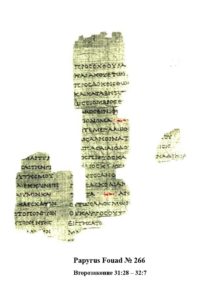 Torah Reading in Synagogues in Egypt; Blessing of Priests (Birkat Kohanim); Triennial Reading of Torah
Torah Reading in Synagogues in Egypt; Blessing of Priests (Birkat Kohanim); Triennial Reading of Torah
Papyrus Fouad 266
We do not know when the custom of the regular reading of the Torah in the synagogue was institutionalized. The Ptolemaic papyri containing the oldest fragments of the scrolls of the Septuagint suggest that this practice was more ancient than is generally admitted. In the Cairo scroll of Deuteronomy (Papyrus Fouad 266), dating from the first century B.C.E., a division of the text points to the current, and probably even more ancient, practice of a triennial reading cycle. The scroll is a copy of the Torah that probably belonged to a synagogue in the Faiyum, where it was employed for public readings. The presence of priests (kohanim) authorizes us to believe that the “benediction of the kohanim” (Birkat Kohanim) was practiced, a rite whose antiquity is now attested by amulets discovered in 1979 in the Valley of Hinnom to the southwest of Jerusalem. They date from the seventh century B.C.E. and contain the oldest fragments of Scripture (Num. 6:24―26) in our possession today.
Source: Modrzejewski, Joseph M. The Jews of Egypt (p. 95 – 96)